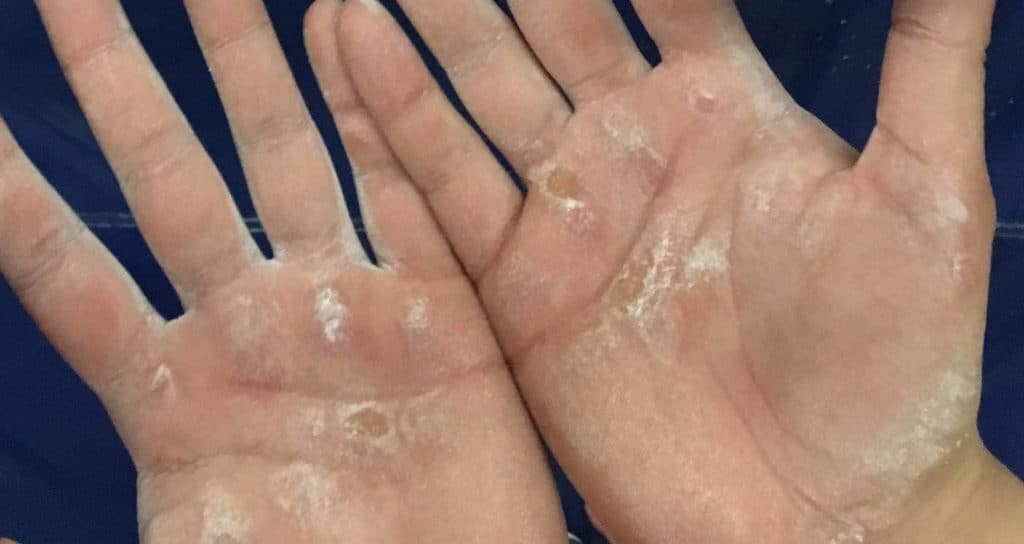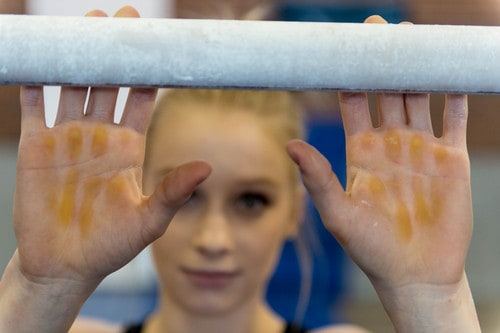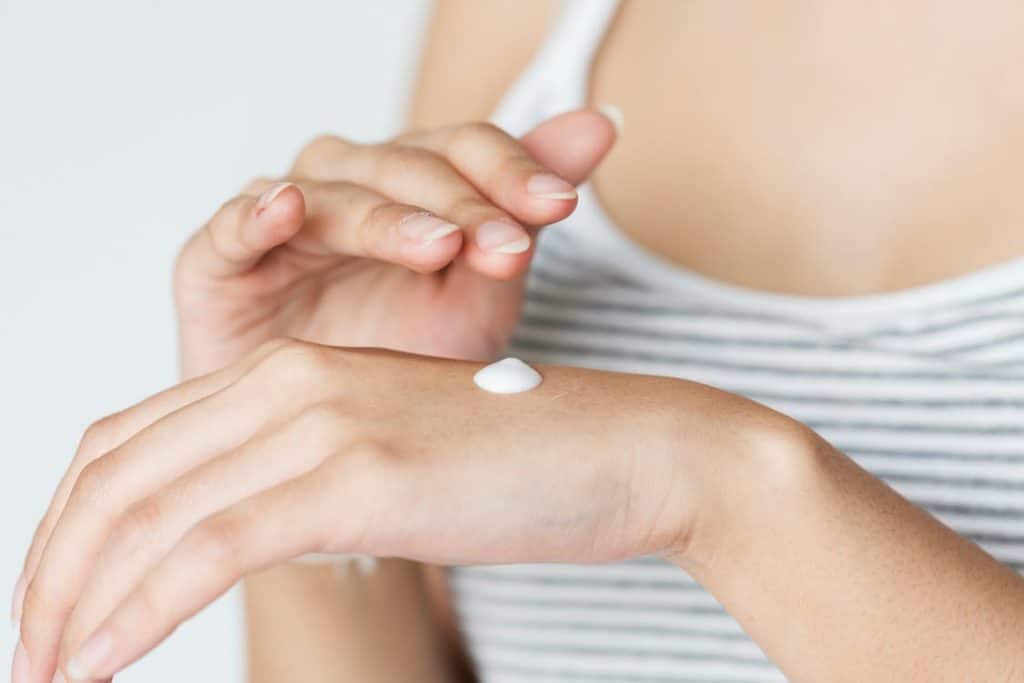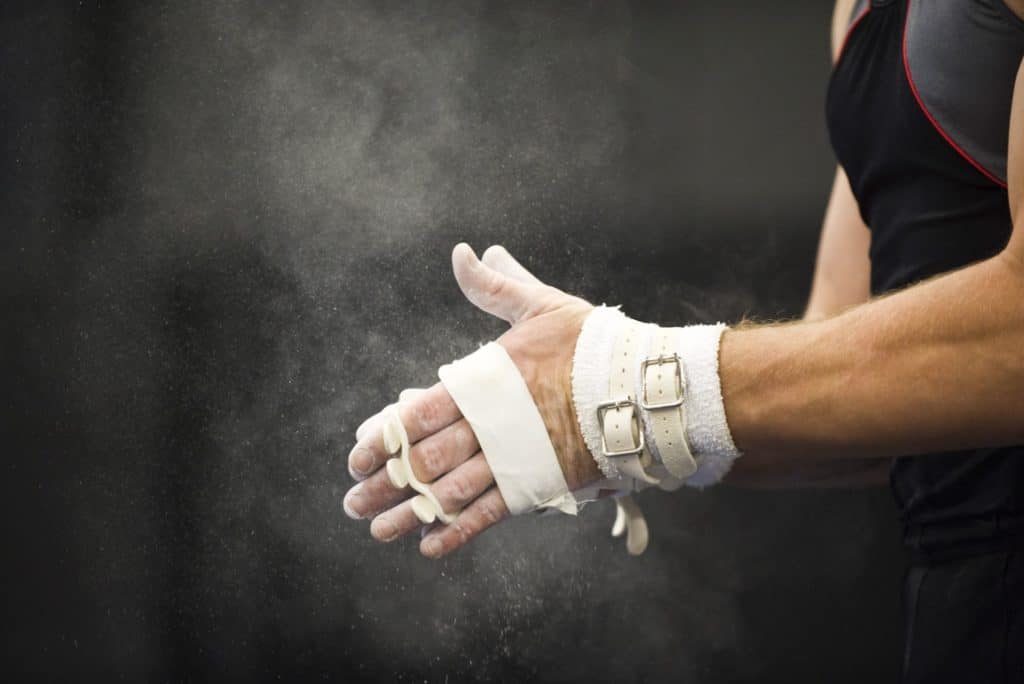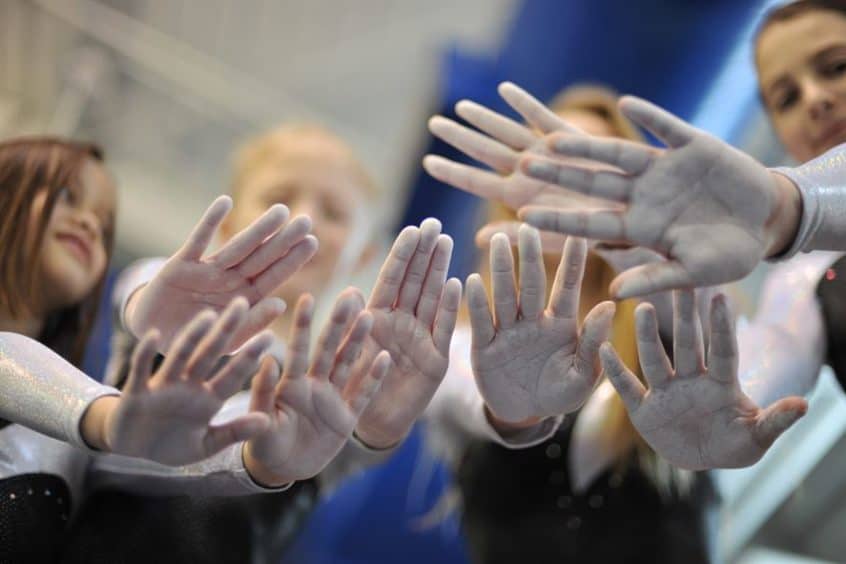Gymnastics rips can be frustrating for both novice and elite gymnasts. It is important to learn how to manage them and quickly heal them. Your rips and blood blister will last longer and keep you out of the gym longer. This article will show you how to quickly heal rips and what preventative steps you can take to avoid them again.
What is a Rip?
A rip refers to when the skin is removed from the hands or wrists. Sometimes, a blister may form or an open wound will appear on the hand. When you repeatedly rub your hands against the bars, rips are common.
Before we get to the root cause of rips, let’s first discuss calluses. WebMD defines calluses as “thickenings in the outermost layer” of the skin. Calluses can form when there is friction or rubbing against the feet or hands.
Gymnasts can develop calluses on their palms from repeated rubbing against the gym bars.
Okay, let’s get back to the rips. Course that what you don’t find on a trampoline for sure.
What Causes Gymnastics Rips
When the skin of the hands is repeatedly exposed and irritated by friction, rips can occur. Examples of repetitive movements include uneven and parallel bars. These rips are more common in gymnasts with little or no hand callus buildup. Protecting the soft skin beneath calluses is key. The skin won’t be fully protected if there isn’t enough callus buildup.
Calluses too thick for gymnasts are equally dangerous. Thicker calluses are more likely than others to catch on and tear. It is important to care for calluses once a gymnast has them. It means that you reduce them to a level that protects your hands and doesn’t get in the way.
Dry skin is another factor that can lead to rips. Because of chalk, gymnasts are more prone to dry skin. It keeps them on the bars, but it also draws out moisture from the skin. To combat dryness caused by chalk, it is crucial that you reintroduce moisture to your hands every day as a gymnast.
How to Heal Gymnastics Rips
Hand rips can be frustrating and painful, but you don’t need to suffer from them for too long. These steps will help you quickly treat your hand rips in gymnastics and get back to the gym.
- Hand Washing: Use soap and warm water to wash your hands as soon as you can. They will itch but it will not be painful. It is important to wash your hands of any chalk that may have collected on your skin.
- Remove any dead skin from the area around your hand. To trim the excess skin, use a pair of sterilized scissors or nail cutters. You must trim excess skin carefully.
- Disinfect This Solid Salve is designed to heal hand rips and cracks from gymnastics. Essential oils that are anti-bacterial and antifungal help to keep infections at bay. Aloe vera, beeswax, and shea butter help to heal and support cell reconstruction. Also, you can use coconut oil.
- Moisturize Dry skin makes healing slower. Because it absorbs quickly into the skin, our Hands RX Cream makes it great for gymnasts. Its natural formula provides the skin with all the hydration it needs. You should keep the area affected hydrated until it is completely healed.
- Use a liquid bandage or bandage once you have hydrated your skin.
- A tea bag can be used. After making a cup, place the tea bags in the fridge. After they have cooled, you can apply the tea bag directly to the rip for about 15-20 minutes. Tea contains tannic acids, which can soothe the pain and promote new skin growth.
How Can You Prevent Rips?
Now that we are aware of the causes of rips, how can we prevent them from happening?
Expert says that the key to preventing rips lies in shaping and smoothing the calluses. The calluses should be thick enough to protect your hands but not too thin that they catch on the bars. He also said that you want them thin enough to protect your body (and yourself!) can keep them moisturized.
Two phases of the RIPT Skin Systems 3 Phase Hand Care Kit are focused on prevention: shaping and smoothing the calluses, and moisturizing.
To prevent rips from happening, there are some simple hand-care techniques you can use for gymnasts.
- Choose a tool to maintain calluses at an operational level. Pumice stones or Callus Shavers are two of the most common options.
- Use high-quality moisturizers daily. Hydrated skin tends to be more flexible and less prone to skin tearing. To keep your hands optimally moisturized, moisturize at least once per day.
- Hand care should be a regular part of your daily routine. It’s just like taking care of your teeth and trimming your nails.
- Grips. Use tape grips or dowel grips if you are recovering from a cut. Give your hands some time to heal.
Hand rips in gymnastics are annoying, but there are simple steps you can take to minimize them. After your hand rip heals you can follow the steps above to maintain your hands in a healthy state and prevent future rips.
How to Care for a Rip
If you have a rip, it is best to stop swinging bars for several days and to take the necessary steps to help the rip heal:
- Wash the rip with antibacterial soap. Although it will sting quite a bit, this is an important step that you should not skip.
- Use small scissors or nail clippers to carefully remove any skin remaining attached.
- Apply Neosporin, an antibiotic cream to relieve the pain and keep it clean.
- Cover it with a bandage Tape the bandage horizontally to your hand if you’re done with bars or vertically to continue bars.
Another Way To Prevent Rips
You can prevent gymnastics rip by checking your grip on the bar. This is something most people forget to do. You can increase the shear force, which can cause blisters and rips.
1. Take a deep breath.
Gymnasts grip the bar tighter when nervous or performing a difficult skill. This issue can be alleviated by practicing mental relaxation techniques and training with frightening skills on the strap bar or with a spot until your confidence increases.
2. Keep your calluses down.
A second important preventive technique is to gently remove any callouses. The greater the chance of the callous tearing away, the larger it is. This can be done with a pumice rock.
3. Don’t pinch your palm.
This technique is best if you don’t have grips. You can press up slightly to hang from your fingers. Instead of sliding your hand down like when you have grips and pinching your hands, you should press up.
Calming and shaping of calluses
The Grindstone, a synthetic pumice rock that you can use in the shower to clean your calluses, is called the Grindstone. Devin suggests that you use the grindstone if your gymnast’s calluses become flaky and white. Devin also said that if your hand feels like it can grasp a shelf, your calluses may need to be thinned so that they don’t catch the bars.
I wanted to know what the benefits were to using RIPT’s Grindstone over other tools such as a razor or natural quartz. He stated that the synthetic pumice stone was the best and could give you the shape you desire so your calluses don’t rip. You were more likely to do more damage than good with other tools due to their lack of control.
F.A.Q.
Why do gymnasts get rips?
Rips are most common in novice gymnasts. This is usually because the gymnast’s grip is too tight due to fear or lack of familiarity. Advanced gymnasts often rip because they allow too much callousness to develop.
How do you stop gymnastics from ripping?
To prevent excess skin growth, callus grooming can easily be performed weekly. Dry skin can also lead to rips. While reducing friction can be helpful, it can also lead to dry skin. It is important to find daily moisturizing that helps maintain skin flexibility and prevents reoccurrences of rips.
How do gymnasts heal rips?
1. Hand Washing…
2. Remove any dead skin…
3. Disinfect…
4. Moisturize…
5. Using liquid bandage…
6. Using a tea bag…


